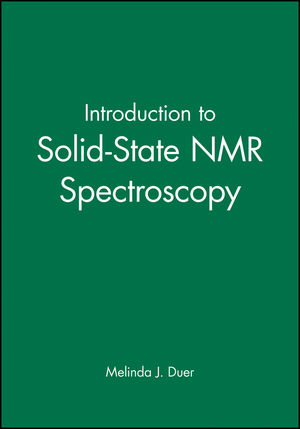Introduction to Solid-State NMR SpectroscopyISBN: 978-1-4051-0914-7
Paperback
368 pages
July 2005, Wiley-Blackwell
 This is a Print-on-Demand title. It will be printed specifically to fill your order. Please allow an additional 10-15 days delivery time. The book is not returnable.
|
||||||
Acknowledgements.
1. The Basics of NMR.
1.1 The vector model of pulsed NMR.
1.2 The quantum mechanical picture: hamiltonians and the Schrödinger equation.
1.3 The density matrix representation and coherences.
1.4 Nuclear spin interactions.
1.5 General features of Fourier Transform NMR experiments.
References.
2. Essential Techniques for Solid-State NMR.
2.1 Introduction.
2.2 Magic-angle spinning (MAS).
2.3 Heteronuclear decoupling.
2.4 Homonuclear decoupling.
2.5 Cross polarization.
2.6 Echo pulse sequences.
References.
3. Shielding and Chemical Shift: theory and uses.
3.1 Theory.
3.2 The relationship between the shielding tensor and electronic structure.
3.3 Measuring chemical shift anisotropies.
3.4 Measuring the orientation of chemical shielding tensors in the molecular frame for structure determination.
References.
4. Dipolar coupling – theory and uses.
4.1 Theory.
4.2 Introduction to the uses of dipolar coupling.
4.3 Techniques for measuring homonuclear dipolar couplings.
4.4 Techniques for measuring heteronuclear dipolar couplings.
4.5 Techniques for dipolar-coupled quadrupolar-spin- ½ pairs.
4.6 Techniques for measuring dipolar couplings between quadrupolar nuclei.
4.7 Correlation experiments.
4.8 Spin counting experiments.
References.
5. Quadrupole Coupling – theory and uses.
5.1 Introduction.
5.2 Theory.
5.3 High resolution NMR experiments for half-integer quadrupolar nuclei.
5.4 Other techniques for half-integer quadrupolar nuclei.
References.
6. NMR Techniques for Studying Molecular Motion in Solids.
6.1 Introduction.
6.2 Powder lineshape analysis.
6.3 Relaxation time studies.
6.4 Exchange experiments.
6.5 2H NMR.
References.
Appendices.
Index



